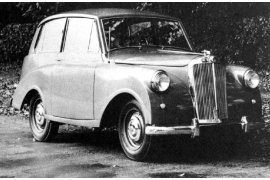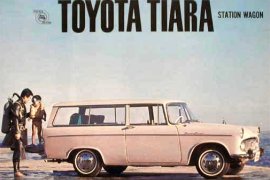Toyota
|
1926 - present |
Country: |
 |
|
Talbot, Standard and Eclipse Motors
The story of Toyota in Australia dates back to 1926. Only the year before, Ford had established its Australian operation under the watchful eyes of Canadian boss H.C. French, having wrested the assembly of Ford cars from the then successful Melbourne operation of Tarrant motors.
But Ford's were not the only cars on offer. Eclipse Motors of Melbourne were, at the time, successfully selling Clement Bayard cars. John Crosby, a shipping agent at the time, was approached by Eclipse managing director Harry Parrington to invest in the firm so that they could acquire the rights to sell the more popular Talbot's. (their meeting was no coincidence, Parrington having sold Crosby a vehicle).
The pair agreed to form a partnership, however it was short lived, and Parrington left the business at the end of the year. Crosby was still full of enthusiasm for the new venture, however his background was as a shipping agent, and he found himself a little out of his depth when it came to the automotive business. The answer came in Fred Matthews, a former
tyre salesman, who offered Crosby the automotive trade know-how to ensure the venture would become a success.
Sales of Talbot's the following year exceeded their wildest expectations, and the pair knew that to grow the company, they would need to begin the assembly of bodies in Australia rather than import fully assembled versions, the resultant cost savings (avoiding the huge import duties) not only allowing greater profitability but, more importantly, allowing them to be priced more keenly (the Talbot's having always been an up-market
automobile).
Manufacture of all body panels was undertaken at Elite Body Works, while final assembly of the cars was performed at JTT Motors. By 1927 Matthews had assumed the role of managing director, while Crosby, ever the entrepreneur, looked at ways to further expand the business.
It was obvious that other marques would need to be acquired, and so Matthews was sent on an overseas trip to secure a partnership. He returned with the rights to
Standard cars, and as it would turn out this was the perfect match, Crosby and Matthews now having a much more affordable car with broader appeal. The subsequent depression proved just how right that decision was, as few could then afford a Talbot!
In fact, by 1933 sales of the Talbot's was almost non-existent, although the company remained as "Talbot and Standard Motors". So well run was the operation that Standard Motors (UK) appointed the company as franchisee's for New South Wales. The Standard's would remain a very popular vehicle throughout the 1930's, although of course World War 2 would intervene. Following the war Standard resumed production of the Eight and Twelve models, and acquired the Triumph Motor Company. The car for which the company is best known in Australia, the Vanguard, was the result of a “one model policy” adopted in 1948.
The Ever Popular Vanguard
Throughout the 1950's the Vanguard became a common site on Australian roads. Perhaps the thing that made it most successful was simply that it was available, however that would be selling the Vanguard a little short. It did offer plenty of ground clearance, something needed at the time with the terrible Australian roads, and it proved to be fairly robust. In fact, during the later production of the Vanguard's many components were compatible with the Ferguson tractor, so getting spare parts in rural Australia was a breeze.
During the 1950's the company located to Port Melbourne, at a time when Standard were reaching their zenith in Australia. There was the Standard 8, Vanguard, Spacemaster and even the Triumph Mayflower. While it was never a serious challenger to
GMH , the company enjoyed a 17% market share, enough to ensure profitability.
 The Triumph Mayflower, more popular in Australia than the UK.
The Triumph Mayflower, more popular in Australia than the UK.
 The Toyota Tiara was assembled locally, the Crown fully imported.
The Toyota Tiara was assembled locally, the Crown fully imported. |
And while the mainstay had become the Vanguard, it was the Triumph Mayflower that had become increasingly more popular with Australian motorists. You can imagine the frustration then when Standard Motors UK decided to ditch the model. Still, the Spacemaster and Standard 8 were competent vehicles, and allowed the Australian operation to continue with their assembly. But the 1960's were a tumultuous time for the UK car industry. Standard were swallowed up by Leyland Motors, and they chose to phase out the "Standard" name in favour of Triumph.
The reasoning was very much associated with the name, the negative connotations of anything deemed to be "Standard" understandably not passing muster. The Australian operation had already changed it's name to Australian Motor Industries Limited (AMI) in an attempt to distance itself from anything simply "Standard". When Leyland, the new owners of Standard, indicated they wished to assume their own production of Triumph's in Australia, AMI needed to find another car to assemble. The answer came with Mercedes-Benz, then a year later with AMC (American Motors Corporation) with the Rambler.
With AMI going from strength to strength, things only got better when Leyland decided not to proceed with their own Australian operation, allowing AMI to begin production of the mighty
Triumph Herald. Some features of the new Herald were considered quite novel at the time, such as independent rear suspension, an incredibly tight turning circle (25 ft.), a collapsible and adjustable
steering column, and a greatly reduced maintenance schedule through use of nylon and rubber bushes that virtually eliminated grease fittings on the chassis.
The Holt Mini-Budget and the Mobilgas Trial
It was a time when many people believed the best motor cars were manufactured using a separate chassis, and the Herald fitted the bill. However only a year after its release, things would take a turn for the worse for AMI, when then Treasurer Harold Holt introduced a mini budget in an attempt to put the
brakes on inflation. He introduced a huge increase in sales tax, and there was an immediate knock-on effect at dealerships around the country.
In a bid to remain viable, AMI sold its share in Mercedes-Benz (Australia) back to the German parent, and even dropped the price of the Herald from £950 to £750 - partly due to the stockpile of unsold Herald's that had resulted from the sales tax increase. AMI were hurting, however the answer was about to be revealed, at the
Mobilgas Trial of 1958. Impressed with the performance of the Japanese Toyopet entry (even though all 3 entered failed to finish the event), negotiations began with the Japanese HQ.
By 1962 agreement had been reached, and production of the Toyota Tiara began, with the Toyota Crown being fully imported. It was a time when many remembered all to well the war, and worse yet a time when most Australian's considered anything Japanese to be inferior. AMI certainly had its work cut out convincing the public of the quality and reliability of their cars. Regardless of perceptions, true or otherwise, the public warmed to the new Toyota's, and by 1964 nearly 1000 Tiara's and Crowns had been sold.
Production of the
Standard Vanguard Six finally came to a halt, some 12 months after production had ended in Britain, however the engine remained in production for fitment to the Triumph 2000. The decision to switch to the manufacture of Toyota's has proved the right one, and given the public perception of the time, was also a brave one to make.
Also see: The History of Toyota (USA Edition) 


